Space pictures! See our space image of the day
A "ring of fire" burns over Easter island in a solar eclipse.
Space can be a wondrous place, and we've got the pictures to prove it! Take a look at our favorite space pictures here, and if you're wondering what happened to today in space history don't miss our On This Day in Space video show here!
A ring of fire over Earth

Thursday, October 3, 2024: The sun and moon align in the sky over Easter Island, or Rapa Nui, in this stunning collage of annular solar eclipse of Oct. 2, 2024 as photographed by eclipse chaser Jamie Carter.
"Well, that was incredible. The tension! A cloud left the sun just 10 seconds before the Baily's beads appeared, and another appeared a minute after the ring ended. We were so lucky," Carter told Space.com.
"It felt incredible to actually see the ring, knowing I had no more than a 50-50 chance. It was so cold in the minutes before annularity," Carter added.
These images show the initial partial phase, "ring of fire" peak and exit partiality during the hours long eclipse from Carter's position on Easter Island in the remote Pacific Ocean. Check out more amazing eclipse photos!
A comet to behold
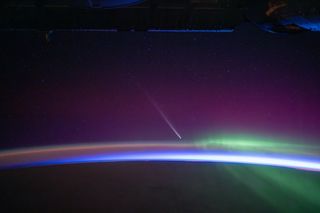
Wednesday, October 2, 2024: The amazing views from space keep coming. This image, taken by NASA astronaut Matthew Dominick, shows the stunning Comet Tsuchinshan-ATLAS as it shined over a nighttime Earth with green auroras below on Sept. 29. "Comet rises up over the horizon just before orbital sunrise with aurora streaking by," Dominick wrote on X (formerly Twitter) while sharing the image.
Comet Tsuchinshan-ATLAS is currently visible in the early morning sky and was visible to the unaided eye until the predawn of Oct. 2. It will return to the early morning sky between Oct. 12 and Oct. 30, making its closest approach to Earth on Oct. 13.
Fire-breathing space Dragon
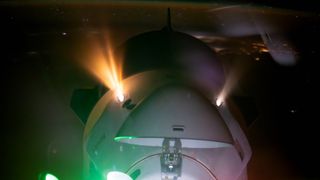
Tuesday, October 1, 2024: SpaceX's Crew-9 Dragon spacecraft, called Freedom, fires its Draco thrusters like some kind of space leviathan in this stunning photo taken from the International Space Station on Sunday, Sept. 29. This photo, which was captured by NASA astronaut Don Pettit on the station, the Dragon is captured as it docked at the ISS to deliver two new crewmembers to the orbiting lab.
Breaking space news direct to your inbox
Sign up to the newsletter for the latest updates on rocket launches, skywatching events and more!
"Here Be Dragons!," Pettit wrote on X while sharing the photo. "Crew-9 Dragon spaceship “Freedom” arrived to @Space_Station last night."
"The approach and docking sequence naturally draws our crew to a window; in this case, about five of us were crowded in Dragon Crew-8 to watch Dragon Crew-9 dock," Pettit added. "With everyone bouncing around for a peek out the window, this photo was a quick handheld snap, complete with window reflections and streaky stars. This Dragon snorts fire! Welcome aboard Crew-9."
Hurricane Helene before making landfall in Florida
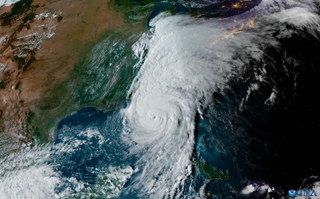
Friday, September 27, 2024: This satellite image from Wednesday (Sept. 25) shows sunset falling on Hurricane Helene as the storm headed toward the southeastern U.S.
Having made landfall during the evening of Thursday (Sept. 26), the major storm reached Category 4 status and started battering states like Florida, Georgia and the Carolinas. Experts warn that this storm is a life-threatening one, and are urging massive evacuations and precautions in most affected areas.
Running with pink...
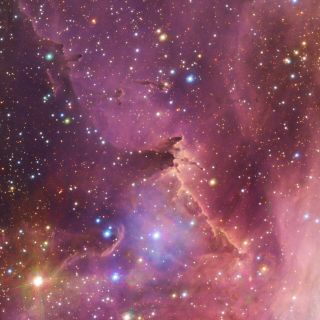
Tuesday, September 24, 2024: Stare deep in the rich pink textures of this gas cloud in the Running Chicken Nebula. The cloudy stellar nursery pictured here, IC2948, is only a small portion of its larger nebula, but contains countless stars in the early stages of life. This image was processed from a 1.5-billion-pixel image taken by the VLT Survey Telescope (VST), at the European Southern Observatory (ESO).
According to ESO, the section of space in the sky only takes up about one-third the size of a full moon, while the whole Running Chicken Nebula spans about 25 full moons across.
An astronomical rise in Cerro Armazones
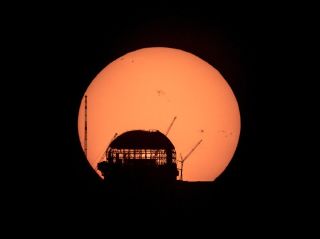
Monday, September 23, 2024: The European Southern Observatory's Extremely Large Telescope (ELT) is rising alongside the sun in this photo from the observatory's home in Cerro Armazones, Chile. Once complete, the building's steel dome, pictured here with sunlight shining through its scaffolding, will be sealed off against the local desert weather, and become the largest optical telescope in the world. The ELT's 39-meter mirror will be capable of collecting tens of millions of times as much light as the human eye.
Stunning comet from the space station
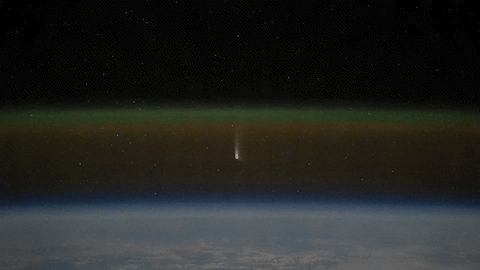
Friday, September 20, 2024: NASA asronaut Matthew Dominick has been releasing stunning astrophotography during his time aboard the International Space Station, capturing gorgeous views of auroras over Earth, meteors exploding in our atmosphere and star trails set against the structures of the ISS. Dominick has been releasing stunning astrophotography during his time aboard the International Space Station, capturing gorgeous views of auroras over Earth, meteors exploding in our atmosphere and star trails set against the structures of the ISS...Read more
Auroras speeding by!

Tuesday, September 17, 2024: A huge plume of plasma and magnetic field from the sun, known as a coronal mass ejection (CME) slammed into Earth, triggering a severe geomagnetic storm. The CME hit around 7:41 p.m. EDT (2341 GMT) yesterday, triggering a dazzling northern lights display visible as far south as the Texas Panhandle.
The CME was released during a colossal X-class solar flare eruption on Sept. 14, which was the fifth largest solar flare of the current solar cycle. Photographer Hasan Akbas captured auroras dancing above Alaska, including this image of the northern lights over a 30 mile-per-hour speed limit sign. — Daisy Dobrijevic
Related: Auroras galore! Severe geomagnetic storm sparks stunning northern lights across US (photos)
Don Pettit sees petite Dawn descending

Monday, September 16, 2024: NASA astronaut Don Pettit has amazed us again with another outstanding photo. Freshly arrived aboard the International Space Station (ISS), Pettit is enjoying his fourth flight to space by leaning into one of his many talents: Photography. Pettit is known for his astonishing captures from the ISS's Cupola module, taking advantage of the large windows and Earth-facing views.
In this photo, Pettit managed to shoot SpaceX's Crew Dragon Resilience on its return trajectory through Earth's atmosphere, carrying Polaris Dawn crew members on their way home from a five-day mission in orbit that included the first-ever commercial spacewalk. In Pettit's photo, the faintest streak can be made out in the dark, black Earth below, headed by the burning teardrop of Crew Dragon as it punches through the atmosphere on its way to a splashdown in the Gulf of Mexico, off the coast off Florida.
Related: SpaceX's private Polaris Dawn astronauts splash down to end historic spacewalk mission (video)
The first commercial EVA

Thursday, September 12, 2024: It's a historic morning. As the sun rose across the eastern portion of the United States, miles above, in orbit of the Earth, Jared Isaacman and the Polaris Dawn crew completed the first-ever commercial spacewalk. Taking turns exiting their Crew Dragon spacecraft, Isaacman, Polaris Dawn mission commander, and Sarah Gillis, mission specialist, took turns testing the mobility and functionality of SpaceX's new extravehicular activity (EVA) spacesuits. Pictured here, Isaacman floats in Dragon's open hatch, grabbing the specially-designed Skywalker mobility aide, as he looks down at the Earth below.
Read more: SpaceX Polaris Dawn astronauts perform historic 1st private spacewalk in orbit (video)
Polaris with a view
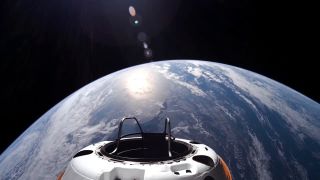
Wendesday, September 11, 2024: Polaris Dawn is well underway, and sharing some breathtaking images from space. SpaceX's most ambitious privately-funded crewed mission has taken its astronauts farther from Earth than any human since Apollo 17. At 458 miles (737 km), the Polaris Dawn Crew Dragon, Resillience, flew through parts of the Van Allen radiation belts, allowing the private crew to perform a handful of novel experiements inaccessible at lower altitudes.
Read more: Polaris Dawn crew flies higher than 1966 Gemini 11 orbital record
Polaris Dawn rises!

Tuesday, September 10, 2024: Polaris Dawn is underway! The private mission funded by billionaire Jared Isaacman lifted off this morning at 5:23 a.m. EDT (0923 GMT) from historic Launch Complex-39A at NASA's Kennedy Space Center (KSC). Roaring off the launch pad, the rocket's nine Merlin engines cast a blisteringly bright light on the still waters around KSC, climbing the sky as the fire's glow reflected off the low, early morning clouds to disperse a dim yellow hue for miles around the space center, until becoming another shimmering point among the stars. Now, the crew will spend the next five days in orbit, and plan to perform the first-ever private spacewalk.
Read more: SpaceX launches Polaris Dawn astronauts to attempt world's 1st-ever private spacewalk (video)
With only their signatures aboard...

Monday, September 9, 2024: Returning to Earth over the weekend, Boeing's Starliner spacecraft has completed its Crew Flight Test (CFT), albeit, without its crew, NASA astronauts Butch Wilmore and Suni Williams, onboard. Pictured, Wilmore and Williams' signatures are seen inside Starliner after its landing at White Sands Missile Range’s Space Harbor, over the weekend.
Related: Astronauts would have been fine on Boeing's Starliner during landing, NASA says
Ahoy in Space!
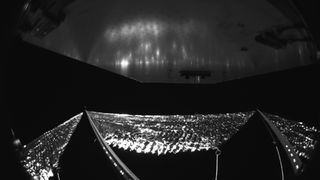
Friday, September 6, 2024: This image is the first-ever selfie of NASA's Advanced Composite Solar Sail System, a new solar sail that unfurled its huge wings in late August. NASA unveiled the image on Sept. 5 as the spacecraft, a tiny cubesat with four extendable sails that increase its size to about 60 square feet (80 square meters). That's half the size of a tennis court. In fact, the sail is so big, you might be able to see it from the ground. NASA will use the solar sail cubesat to test sail techniques and technology that could help future spacecraft sail across the solar system.
Related: NASA's solar sail spacecraft is visible in the night sky. Here's how to see it
-- Tariq Malik
Dawn Flyby

Thursday, September 5, 2025: As the Polaris Dawn astronauts await favorable weather, the crew is staying busy. The Polaris Program posted to social media this morning, highlighting a flyby they performed over NASA's Kennedy Space Center, buzzing by their ride to space below. Aboard, Polaris Program Content Director John "Snap" Kraus accompanied the crew to shoot the scene during their flight.
"The Polaris team conducted a flyover at Kennedy Space Center on Tuesday with Falcon 9 and Dragon vertical on pad 39A. Thanks to @NASAKennedy, @SLDelta45, and @SpaceX for the support," the post reads.
SpaceX rockets ready and flying
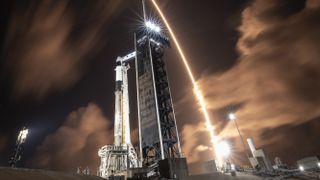
Tuesday, Sept. 3, 2024: A SpaceX Falcon 9 rocket streaks over another in this stunning photo by launch photographer Ben Cooper for SpaceX in the wee hours of Saturday, Aug. 31. The launch sent 21 Starlink satellites into orbit as the rocket lifted off from a SpaceX pad at Cape Canaveral Space Force Station, with SpaceX sharing the photo on X. Cooper captured the moment in this long exposure taken from Pad 39A of NASA's Kennedy Space Center, where ANOTHER SpaceX Falcon 9 rocket awaits its own launch to send four people to orbit on the private Polaris Dawn mission. SpaceX followed up the Florida Starlink launch with yet another batch of Starlink satellites about 65 minutes later. That mission also launched 21 Starlink satellites to orbit from SpaceX's pad at Vandenberg Space Force Station in California. The first-stage boosters of the Falcon 9 rockets used in both launches landed successfully on drone ships located off shore .-- Tariq Malik
Archives
Check out our Image of the Day Archives for more awesome photos.
Image of the Day 2020 Archive
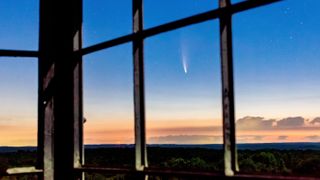
Image of the Day 2019 Archive
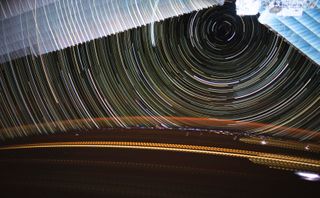
Can't find the date you're looking for? It may have been a weekend or holiday, when we don't normally update our Image of the Day.
Click 'NEXT PAGE' below for August >
August >
Join our Space Forums to keep talking space on the latest missions, night sky and more! And if you have a news tip, correction or comment, let us know at: community@space.com.

Space.com is the premier source of space exploration, innovation and astronomy news, chronicling (and celebrating) humanity's ongoing expansion across the final frontier. Originally founded in 1999, Space.com is, and always has been, the passion of writers and editors who are space fans and also trained journalists. Our current news team consists of Editor-in-Chief Tariq Malik; Editor Hanneke Weitering, Senior Space Writer Mike Wall; Senior Writer Meghan Bartels; Senior Writer Chelsea Gohd, Senior Writer Tereza Pultarova and Staff Writer Alexander Cox, focusing on e-commerce. Senior Producer Steve Spaleta oversees our space videos, with Diana Whitcroft as our Social Media Editor.
-
rod ReplyThe Exoplanets Channel said:The images are truly breath-taking.
The Exoplanets Channel, what star and reddish exoplanet is shown in your picture, looks like about 8" angular separation? I use this site as my canonical reference to exoplanets, The Extrasolar Planets Encyclopaedia Currently 4150 exoplanets are listed. -
swiggly ReplyThe Exoplanets Channel said:The images are truly breath-taking.
My Comet Image:
Neowise -
rod Reply
This is a very good image here. In enjoyed some recent views of NEOWISE using my 90-mm telescope at 40x early, shortly after 0415 EDT. Bifurcated tail obvious too.swiggly said:My Comet Image:
Neowise -
Helio The IOD image for yesterday of the Veil nebula is stunning! The graphics are such that it's almost as if it has an oil film on top. It has both 3D and texture feel to it.Reply -
Astro.Letizia I hope they start posting these daily again! I always start my day off with the newest image but it's been a couple of months now :(Reply